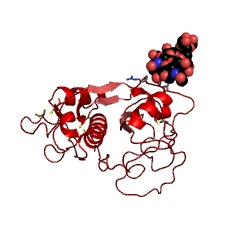Bromelain
From Proteopedia
| |||||||||||
Contents |
Image of Protein
Function
As a potential anti-inflammatory agent, it may be useful for treating arthritis. Systemic enzyme therapy (consisting of combinations of proteolytic enzymes such as bromelain, trypsin, chymotrypsin, and papain) has been investigated in Europe to evaluate the efficacy of proteolytic enzymes in the treatment of breast, colorectal, and plasmacytoma cancer patients[1] Bromelain is one of the most popular proteases to use for meat tenderizing.
History
Pineapples have a long tradition as a medicinal plant among the natives of South and Central America. The first isolation of bromelain was recorded by the Venezuelan chemist Vicente Marcano in 1891 by fermenting the fruit of pineapple.In 1892, Russell Henry Chittenden, assisted by Elliott P. Joslin and Frank Sherman Meara, investigated the matter more completely,and called it 'bromelin'. Later, the term 'bromelain' was introduced and originally applied to any protease from any member of the plant family Bromeliaceae.
Temperature stability
At the optimum temperature, the enzyme acts the fastest, but (at least the fruit variant) is destroyed within few minutes. After an hour at 50 °C (122 °F), 83% of the enzyme remains, while at 40 °C (104 °F), practically 100% remains. As a result of this, the optimum temperature for maximum cumulated activity over time is 35-45 °C. At room temperature, the enzyme can survive at least a week even under multiple freeze-thaw cycles.
3D Bromelain Structure
We can click the ball and stick to see the ball and stick model of this protein. And we can also add label on the 3D model.
References
- ↑ Beuth J. Proteolytic enzyme therapy in evidence-based complementary oncology: fact or fiction? Integr Cancer Ther. 2008 Dec;7(4):311-6. doi: 10.1177/1534735408327251. PMID:19116226 doi:http://dx.doi.org/10.1177/1534735408327251

